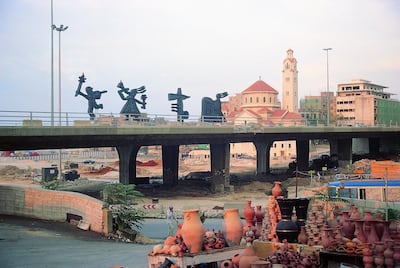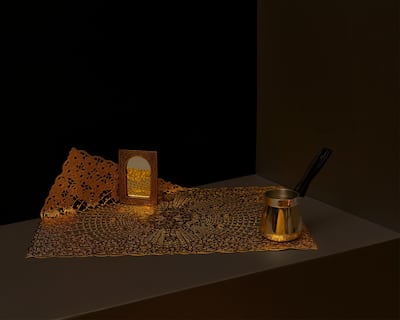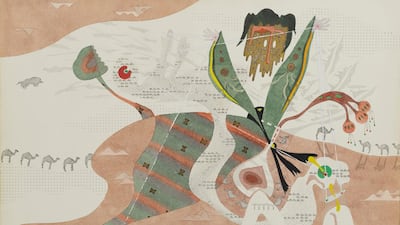For Nadim Karam, bigger is better. The Lebanese artist is known for his public art sculptures or what he calls Urban Toys – large-scale steel structures of imagined creatures, some up to 8.5 metres in height, such as his 2006 project The Travelers, a permanent installation of nine sculptures on Melbourne's Sandridge Bridge. Yet more often than not, these dense works often begin with delicate lines on paper.
Throughout his practice, which spans more than 40 years, he has produced hundreds of drawings and paintings that not only function as preliminary studies for his public projects, but also serve as his own diaristic chronicling of thought.
For the first time, the artist is opening the doors to his private studio in Daroun, Lebanon, to present his archival material of sketchbooks, paintings and performance art videos in an exhibition entitled Shorthand: Nadim Karam, Notes from the Archive. Trained as an architect in Japan, Karam set up his atelier with his architectural office Hapsitus last year. Named A.MUSE.UM and nicknamed "muse", it is connected to the artist's private residence.
Curated by Rachel Dedman, Shorthand is being held in association with the 10th anniversary of Beirut Art Fair (BAF). Over the next week, Beirut will be abuzz with satellite events linked to the fair, including Beirut Design Fair and Beirut Art Week. Karam's exhibition opens today, at the same time as the fair, and will run for six weeks after it closes.
“Nadim is one of these artists whom people associate with monumental sculpture,” says Dedman. “When I found out that he has sketched daily for the last four decades, and when I saw all this intimate, gestural and spontaneous material, I was excited to use that to explore the origins of his practice, and the foundations behind the work we know so well.”
In these drawings, we see the origins of the animal-like characters and symbols that have become part of Karam's artistic language. A watercolour on paper sketch from 1985, for example, depicts organic forms bursting out of sand dunes. These curves and lines are somewhat replicated in his well-known Archaic Procession figures, of which there are 1,001, which have been translated into sculptures and paintings since the 1990s.
During his decade in Tokyo, where he studied architecture, Karam developed what he called “utopic” ideas of his home country Lebanon. These themes of memory and self-sustaining narratives have become a significant part of his practice, especially in his move back to Beirut in the 1990s.

"Lebanon was in this stage of recovery, but buildings that were not safe were being destroyed. We were going through a city in rewind. Around 250 buildings were destroyed. Suddenly, you saw a city that became a huge canvas, and everything was changing because of that," says Karam, who developed urban interventions such as Hilarious Beirut and Archaic Procession in response to this architectural gap.
Though he has had to put aside works in progress and reconfigure his studio to accommodate for the show, he says he will keep A.MUSE.UM open for visitors at weekends until the end of October, when he plans to unveil new works in the space.
Discovery and rediscovery at the heart of this year’s BAF
In addition to Shorthand, Dedman has curated the "Revealing" section of BAF, which focuses on lesser-known artists whose works may not have been shown at an art fair before. It is an interesting non-profit initiative in the midst of a commercial event, but the curator considers it an important one. "I know how difficult it is economically at the moment to be an artist and how much you're expected to do on exposure alone. So the non-profit side of things – that it costs nothing for the artist to participate, and no commission is taken on sales – was fundamental," she says.

Selecting 10 artists from an open call, Dedman has included works by Maya-Ines Touam, who draws from her French-Algerian background to explore ideas of identity, religion and femininity. Her still-life compositions appear traditional, almost painterly, though they are actually a combination of objects from East and West, each with their own set of cultural references.
There's also the thought-provoking works of Nadim Choufi, who looks at the impact of technology on our collective psyche. The text-based installation All of My Mistakes, for example, is a two-year-long documentation of the autocorrect feature on his electronics, looking at how AI can shape the way we use language.
Highlighting lesser-known artists and "unseen" works are all part of the fair's curatorial direction (themed "Choice of Discovery") this year, says Joanna Abou Sleiman-Chevalier. "As artistic director for this 2019 edition, I am zooming in on the emerging scene, yet not focusing on a specific region, as the fair is part of an interconnected international scene of discoveries." She adds that BAF is "devoted to the discovery of the young local and international contemporary art scene, and to the rediscovery of artists whose work might unfairly be less acknowledged."

Sleiman-Chevalier also acknowledges the inclusion of young galleries (less than a year old) in the exhibitors list, including ArtSpace from Casablanca and Wip from Beirut, which are presenting alongside more established names such as kamel mennour, Galleria Continua and Primo.
Satellite events as part of Beirut Art Week include the unveiling of Lebanese-Senegalese artist Hady Sy's sculpture Wall of Hope, installed at Beirut's Green Line. Other highlights include the takeover of an abandoned factory by South Border Gallery with the exhibition Study for a Soap.
Despite challenges, Beirut’s art scene still enjoys freedom of expression
All these events are taking place in the midst of economic and social turmoil for Lebanon, including tension with Israel, currency devaluation, an influx of refugees and a refuse crisis that is yet to be fully solved. "The economic situation is not good at the moment, and of course this affects artists and institutions. Funding, mobility, and freedom of speech remain key issues, all of which shape the way we are able (or unable) to produce," says Dedman. "It's hard to identify shifts while they're happening, but I'm always struck by the fact that artists here are much less afraid of being political in their practices than in Europe."
Laura d'Hauteville, founder and director of BAF, remains adamant that the art scene is stronger than ever, citing 32,000 visitors to last year's fair, the most since 2010. More importantly, she sees the fair's openness as its strongest point. "BAF is the only place in the Mena region where contemporary artists have unfettered freedom of expression, and where they are appreciated by the Lebanese and foreign public.
"Art is a vector of dialogue. Throughout the most politically difficult moments in the region in the past years, Beirut Art Fair gave a platform to artists who had to flee their countries, who weren't welcome there for political reasons or who suffered censorship." Karam agrees. While he acknowledges problems with a lack of funding, and a shortage of institutions and exhibitions spaces, he says freedom of expression is what sets Lebanon apart. "The main thing that the Lebanese can count on is creative expression and the freedom of expression. That's very important for us. The more they will destroy, the more we will create."
Although Lebanon's constitution guarantees freedom of speech in its laws, it is important to see these comments in context. While the country may enjoy more freedom in this realm than its neighbours, instances of arrests and censorship have taken place recently.
“We would like to avoid such things,” says Karam. “Creative expression is our only means of moving forward. Each of us have to be inventive in meeting budgets, finding spaces to exhibit. It’s quite tough, but we count on this – the freedom of expression.”
Beirut Art Fair runs until Sunday, September 22; Beirut Art Week runs until Wednesday, September 25; Nadim Karam’s Shorthand exhibition runs until Sunday, October 27



